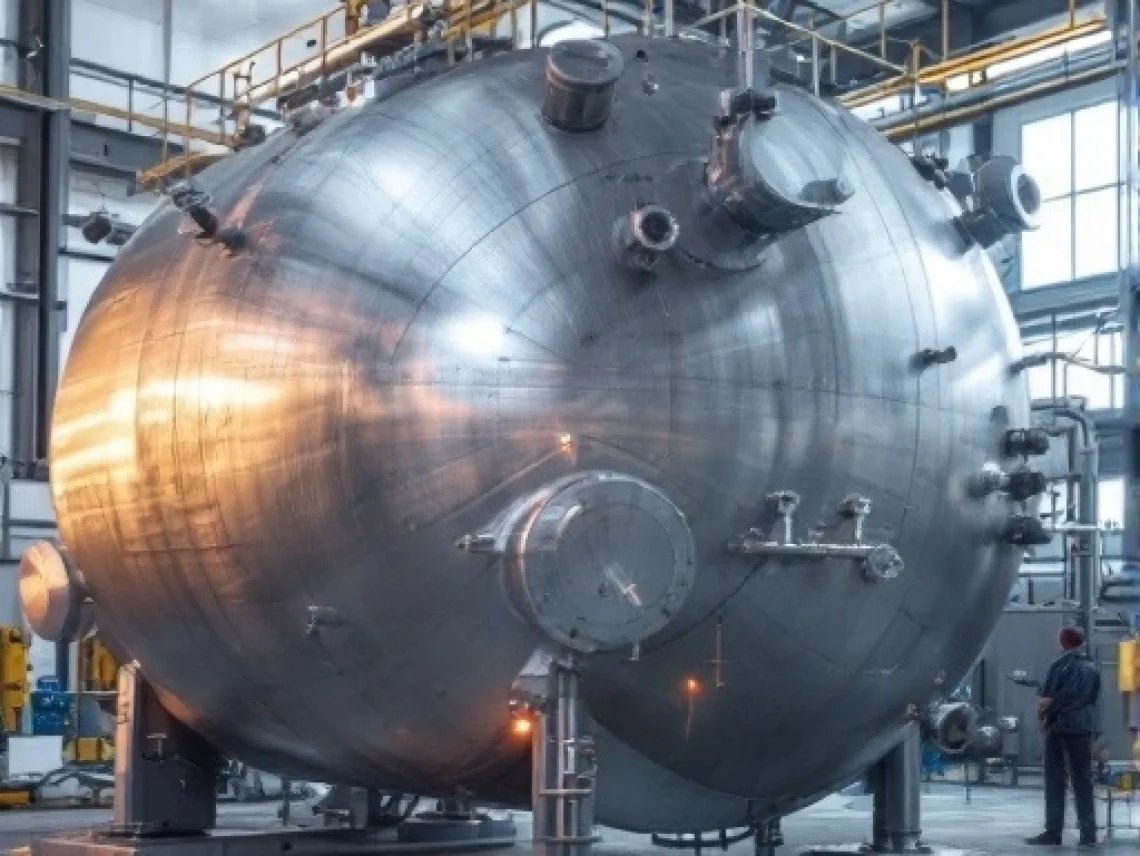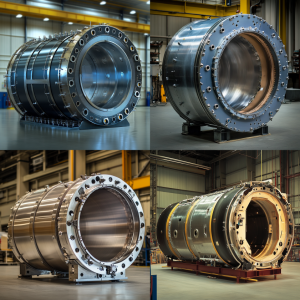What Is a Type 3 Pressure Vessel?

Table of Contents
ToggleUnderstanding Pressure Vessel Types
Pressure vessels are sealed containers used to hold gases or liquids at a pressure significantly different from the ambient environment. These vessels are critical in industries such as oil and gas, chemical processing, energy storage, aerospace, and transportation. Because they often contain flammable or high-pressure substances, they are designed and fabricated with extreme precision under strict regulations.
Common Types of Pressure Vessels
Pressure vessels are generally classified by their construction materials and the nature of their reinforcement. These classifications include:
- Type 1: All-metal construction (typically steel or aluminum)
- Type 2: Metal liner with a hoop-wrapped composite reinforcement
- Type 3: Metal liner with a full composite wrap
- Type 4: Full composite structure with a polymer liner
This progression from Type 1 to Type 4 marks the evolution toward lighter, stronger, and more efficient vessel designs. In this blog, we take a deep dive into Type 3 pressure vessels, examining what they are, how they’re built, and where they shine.
What Makes a Pressure Vessel "Type 3"?
A Type 3 pressure vessel is defined by its hybrid construction. It features a metallic liner, often made from aluminum, wrapped in a high-strength composite material, typically carbon fiber or fiberglass. This composite wrap covers the entire pressure-bearing surface of the vessel.
This design strikes a balance between structural integrity and weight reduction. While the metal liner ensures gas impermeability and structural form, the composite overwrap bears the brunt of the pressure, making the vessel stronger and lighter than its fully metallic counterparts.
Core Materials Used in Type 3 Vessels
Liner Material:
- Typically aluminum 6061-T6, chosen for its weldability, corrosion resistance, and light weight.
- Functions as a gas barrier and provides shape to the vessel.
Composite Wrap:
- Carbon fiber is the most common, offering a superior strength-to-weight ratio.
- Glass fiber or aramid (Kevlar) may also be used, depending on application-specific requirements.
Resin Matrix:
- Epoxy resins are used to bind fibers, contributing to structural cohesion and environmental resistance.
Advantages of Type 3 Pressure Vessels

Type 3 vessels bring together the best of metal and composite technologies, offering a long list of benefits for modern industry.
Lightweight Performance
Compared to Type 1 and Type 2 vessels, Type 3 vessels are significantly lighter. The composite overwrap handles most of the internal pressure, allowing for thinner, lighter liners. This makes them ideal for mobile and weight-sensitive applications like aerospace, fuel transport, and portable storage systems.
Higher Pressure Ratings
Because the composite wrap carries the load, Type 3 pressure vessels can safely handle pressures upwards of 3,600 to 5,000 psi, depending on their design and certification standards. This high-pressure capability makes them suitable for compressed natural gas (CNG) and hydrogen storage.
Corrosion Resistance
While metals can corrode over time, especially when exposed to reactive gases or harsh environments, composite materials offer enhanced corrosion resistance. This extends the service life of the vessel and reduces maintenance needs.
Improved Fatigue Life
The fiber wrap structure resists crack propagation and fatigue, especially under cyclical loading conditions. This characteristic is crucial in transportation systems where pressure cycles occur frequently.
Enhanced Safety
When manufactured according to ASME and ISO standards, Type 3 vessels provide excellent rupture resistance. Even in failure, they tend to split in a non-catastrophic manner due to the properties of the composite material.
Common Applications and Use Cases
Type 3 pressure vessels are increasingly used across multiple high-performance sectors, thanks to their strength, safety, and portability.
Compressed Natural Gas (CNG) Storage
CNG vehicles and transportation trailers benefit from Type 3 cylinders due to their lightweight design and high storage pressure. This helps maximize vehicle efficiency and fuel capacity.
Hydrogen Fuel Systems
As part of the clean energy shift, hydrogen fuel is gaining prominence. Type 3 vessels are widely used in hydrogen-powered buses, trucks, and fueling stations. Their high-pressure handling and lightweight construction are vital to the success of these systems.
Aerospace and Defense
In aviation and military operations, every pound matters. Type 3 vessels are used for emergency oxygen, inert gas systems, and propulsion components in spacecraft due to their low weight and structural resilience.
Industrial Gas Storage
Industrial facilities that require portable or stationary gas storage often use Type 3 vessels for oxygen, nitrogen, argon, and specialty gases.
Renewable Energy Storage
In off-grid and hybrid energy systems, Type 3 pressure vessels store compressed air or hydrogen, enabling load balancing and backup power.
Type 3 vs. Other Pressure Vessel Types
Understanding how Type 3 pressure vessels compare to their counterparts is key to selecting the right solution for your application.
Type | Liner | Wrap | Weight | Cost | Use Case |
Type 1 | Steel or aluminum | None | Heaviest | Lowest | Stationary storage, high durability |
Type 2 | Metal | Hoop wrap (partial) | Moderate | Moderate | Automotive, mid-pressure storage |
Type 3 | Metal (Aluminum) | Full wrap (carbon) | Light | Higher | Mobile fuel, aerospace, and high-pressure use |
Type 4 | Polymer | Full wrap (carbon) | Lightest | Highest | Advanced hydrogen systems, future mobility |
For many manufacturers, Type 3 pressure vessels provide the optimal balance between performance and cost, especially when high-pressure, portable storage is needed.
Design Standards and Compliance
Like all pressure vessels, Type 3 designs must meet rigorous safety and performance standards. Common certifications include:
- ASME Section X: The American Society of Mechanical Engineers (ASME) standard for fiber-reinforced pressure vessels
Learn more from ASME here - ISO 11119-2: International standards for Type 3 cylinders used in transportation and storage of gases
ISO overview available here - DOT/TC/UN Certifications: For transportation and global shipment of hazardous materials.
It’s essential to work with an experienced manufacturer that adheres to these standards. At Red River, our engineering team ensures every vessel is built for performance, safety, and compliance.
Need a reliable partner?
Frequently Asked Questions
1. What is a Type 3 pressure vessel made of?
Type 3 pressure vessel features a metal liner (typically aluminum) and a full composite wrap made of carbon or glass fiber reinforced with epoxy resin.
2. How does a Type 3 vessel differ from a Type 2?
Type 2 vessels have a partial composite wrap (only in stress areas), while Type 3 vessels are fully wrapped, resulting in better weight reduction and pressure performance.
3. Are Type 3 vessels more expensive than other types?
Yes, they are more costly than Types 1 and 2, but they offer superior performance and lighter weight, which can reduce operational costs in transportation and energy usage.
4. Can a Type 3 vessel be used for hydrogen?
Absolutely. Type 3 vessels are widely used for hydrogen storage in fuel cell vehicles and refueling stations due to their high-pressure capability and safety profile.
5. What pressures can Type 3 vessels typically withstand?
They can handle pressures of up to 5,000 psi, with some designs capable of even higher ratings under specialized conditions.
6. Are Type 3 pressure vessels recyclable?
Yes, the aluminum liner is recyclable. However, recycling composite materials can be more complex and depends on local capabilities and the resin system used.
7. What industries use Type 3 pressure vessels the most?
Key industries include transportation (CNG and hydrogen fuel), aerospace, military, industrial gas supply, and renewable energy.
8. Does Red River manufacture custom Type 3 pressure vessels?
Yes. We specialize in custom pressure vessel design and fabrication, including prefabricated spools and skid packages. Learn more at our homepage or contact us today.
Key Takeaways
- Type 3 pressure vessels consist of an aluminum liner fully wrapped in composite material (typically carbon fiber).
- These vessels offer high-pressure ratings, reduced weight, corrosion resistance, and extended fatigue life.
- Common use cases include CNG and hydrogen storage, as well as aerospace, military, and industrial gas applications.
- They are a popular choice for manufacturers balancing cost-efficiency with high-performance demands.
- Red River provides custom-built, ASME-compliant Type 3 pressure vessels with American craftsmanship and values.
Table of Contents
ToggleRelated Blog Post
- What is the difference between a pressure vessel and a compressor?
- What is the most common type of pressure vessel used in industry?
- What are the different types of pressurised tanks?
- How many types of ship vessels are there?
- What is a Type 3 pressure vessel?
- What is a typical pressure vessel?
- What is the difference between Class 1 and Class 2 pressure vessels?
- Which pressure vessel is strongest?
- What are the four most common types of heads for pressure vessels?
- What is the difference between Type 3 and Type 4 hydrogen tanks?
- What are different codes used for pressure vessels?
- What is a Category 3 pressure area?
Solutions
In the realm of industrial solutions, Red River emerges as a pioneer, offering a diverse range of custom-engineered products and facilities. Among our specialties is the design and production of Custom/OEM Pressure Vessels, meticulously crafted to meet individual client requirements, ensuring performance under various pressure conditions. Our expertise extends to the domain of prefabrication, where Red River leads with distinction.
The company excels in creating prefabricated facilities, modules, and packages, reinforcing its stance as a forerunner in innovation and quality. This proficiency is further mirrored in their Modular Skids offering, where they provide an array of Modular Fabricated Skid Packages and Packaged equipment. Each piece is tailored to client specifications, underlining their commitment to delivering precision and excellence in every project they undertake.
